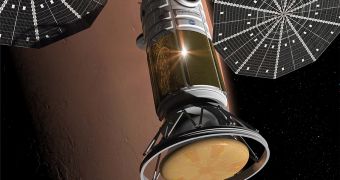The Inspiration Mars project plans to send a married duo of astronauts to the Red Planet by early 2018, using NASA assets, federal funding from the US government, and a lot of good luck. This will not be a settlement mission, but rather a manned flyby of our neighboring planet.
The outline of the endeavor, called Mission for America, was unveiled yesterday, November 20. Spearheading the project is the first space tourist, multimillionaire Dennis Tito. He hopes that a collaboration with NASA would provide much of the equipment and know-how needed for the flight.
With current plans calling for the mission to launch in early January 2018, federal funding is definitely needed. “Perhaps several hundred million dollars in new federal spending can make this mission happen,” Tito says, quoted by Space.
The spacecraft carrying the two astronauts would depart during a launch window that lasts from December 25, 2007 to January 5, 2018. During this time, Earth and Mars would be in a type of alignment that would shorten the amount of time the crew will have to spend in space.
It is currently estimated that the flight would take 501 days to complete, for the entire round-trip journey. The crew would fly at less than 160 kilometers (100 miles) above the surface of Mars, before finally returning for a May 2019 landing.
“We now call on our nation’s leaders to seize this singular opportunity to begin human exploration of the solar system and affirm America’s leadership throughout the world,” Tito says.
“There'll be a lot of science return and technology return. We will, I think, sort of break the sound barrier for going to Mars and back, enabling a range of missions to occur in the future,” Inspiration Mars chief technology officer Taber MacCallum told reporters yesterday.
He added that the flyby mission would require the use of NASA's new heavy-lift rocket, the Space Launch System (SLS), which should finish testing by then. The first flight of the SLS is currently scheduled for the end of 2017.
The mission involves two rocket launches, Inspiration Mars proponents say. The SLS rocket would deliver an SLS upper stage to Earth's orbit, alongside an Earth reentry pod, an astronaut habitat modeled on the Cygnus spacecraft developed by Orbital Sciences Corporation and a service module.
Once these modules are connected, another rocket-and-spacecraft combo would deliver the astronauts. Upon returning to Earth, the crew will step into the reentry module, which will most likely be a NASA Orion Multipurpose Crew Exploration Vehicle.
“We submit this report with unreserved faith in the men and women of NASA, with a singleminded commitment to surmounting every obstacle, and with complete confidence that this mission can be done,” the Inspiration Mars team wrote in the proposal.

 14 DAY TRIAL //
14 DAY TRIAL //